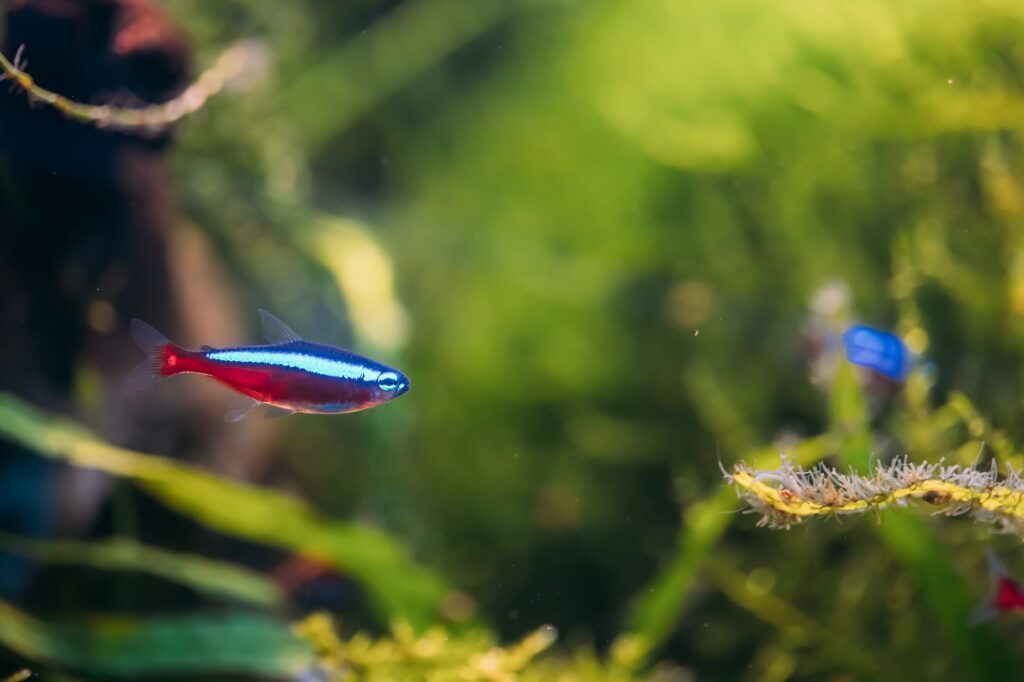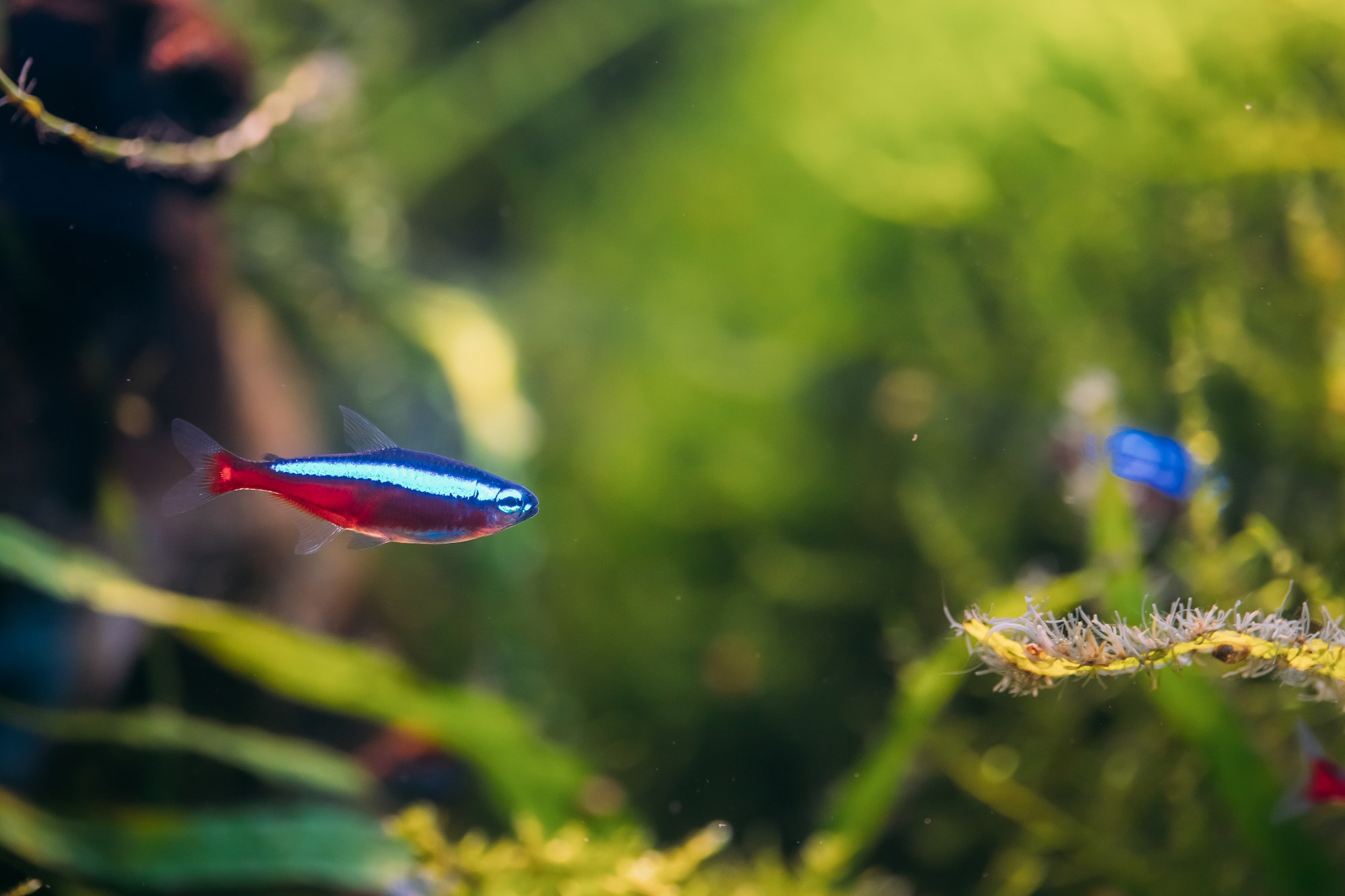The world of Cardinal Tetras, also known by their scientific name Paracheirodon axelrodi, is as vivid as it is fascinating. These radiant fish belong to the Characidae family and are close kin to the Neon Tetra and Green Neon Tetra. With striking blue and red colors that span the length of their bodies, they are undoubtedly a sight to behold in any aquarium setting.
Table of Contents
Cardinal Tetras aren’t rare gems; in fact, their popularity in aquariums has remained unwavering over the decades. It is important to note that while there are no major variations of this species, their close relatives, the Neon and Green Neon Tetras, are often incorrectly identified as such.
Native to the serene waters of the upper Orinoco and Negro Rivers in South America, these mid-dwelling fish have specific care needs. While they may have a preference for small invertebrates and crustaceans, these incredible creatures can adapt to a controlled environment where they thrive on high-quality flake food and nourishing brine shrimp. Their harmonious nature makes them perfect for community tanks, always ensuring they are in the company of other non-aggressive mates.
In terms of statistics, these radiant creatures can live up to 2 to 4 years in captivity, reaching a length of about 3 to 5 cm. Cardinal Tetras have a glowing bioluminescence, a trait they use to communicate in their naturally dim habitats. They are distinct from Neon Tetras; the continuity of their red and blue stripes sets them apart. Fun tidbits? These tetras got their name from the Roman Catholic cardinals’ crimson robes. They even boast a unique adaptation in their eyes, enabling them to see in the darkest of waters.
Delving a bit into history, the 1950s saw the introduction of Cardinal Tetras to the aquarium trade. The species was named by Dr. Leonard P. Schultz, an esteemed American ichthyologist, who chose to honor the passionate tropical fish enthusiast Herbert R. Axelrod by giving it his name.

Key Information
| Family | Characidae |
| Price | Typically ranges from $1 to $3 per fish, depending on region and store availability. |
| Common Names | Cardinal Tetra, Red Neon Tetra |
| Variants | None. However, closely related to Neon Tetra and Green Neon Tetra. |
| Ideal Tank Size | At least 20 gallons for a small school. |
| Water Parameters | Temperature: 73°F – 81°F (23°C – 27°C), pH: 6.0 – 7.5, Hardness: 1° to 12° dKH. |
| Lifespan | 2 to 4 years in captivity. |
| Full Size | 3 to 5 cm in length. |
| Natural Environment | Upper Orinoco and Negro Rivers in South America. |
| Behavior | Peaceful, shoaling fish. Prefers to be in groups. |
| Habitat Preference | Mid-water dweller. |
| Aquarium Decoration | Live plants, driftwood, and a darker substrate to mimic their natural environment. |
| Ideal Tank Mates | Peaceful fish like Corydoras, Rasboras, and small Loricariids. |
| Fish to Avoid | Larger, aggressive fish like Cichlids, large Catfish, and other predatory species. |
| Best Foods/Diet | High-quality flake food, brine shrimp, micro worms, and other small live or frozen foods. |
| Disease | Prone to Ich and Neon Tetra Disease if water quality drops or if exposed to stress. |
| Sex-Switch | Not documented for this species. |
| Gender Differences | Minimal. Males tend to be slightly slimmer, while females may appear slightly plumper. |
| Care Level | Moderate. They require stable water parameters and good tank maintenance. |
| Breeding Level | Moderate. They can be bred in captivity, but require specific conditions and water parameters. |
Ideal Tank Mates
Cardinal Tetras are known for their peace-loving nature, which makes them compatible with a variety of tank mates. Selecting the ideal companions for your Cardinal Tetras is crucial. It is important to choose species that have similar water parameters, display non-aggressive behavior, and won’t perceive the tetras as food. Here’s a detailed look at ten ideal tank mates for these vibrant beauties:
- Corydoras Catfish (Corydoras spp.)
A bottom-dwelling fish, Corydoras are peaceful scavengers. Their docile nature and the fact that they inhabit a different level of the tank make them ideal tank mates for Cardinal Tetras. - Rasboras (Boraras and Harlequin Rasboras)
These small, colorful fish are peaceful shoalers that coexist well with Cardinal Tetras. They often swim in the middle and upper parts of the tank, adding movement and color. - Small Loricariids (Otocinclus, Ancistrus)
Often known as sucker-mouthed catfish, these species are herbivorous and non-aggressive, making them suitable tank mates. Otocinclus, in particular, are great algae eaters, helping to maintain a clean tank environment. - Dwarf Gourami (Trichogaster lalius)
With their calm demeanor and stunning colors, Dwarf Gouramis can coexist harmoniously with Cardinal Tetras. They often inhabit the top levels of the tank, minimizing any territory disputes. - Small Tetras (Neon Tetra, Ember Tetra, Rummy nose Tetra)
Similar in size and temperament to the Cardinal Tetra, these tetras can comfortably share space, creating a bustling, colorful community. - Hatchetfish (Gasteropelecidae family)
Known for their unique body shape, Hatchetfish are top-dwelling species. Their peaceful nature makes them compatible with Cardinal Tetras. - Ghost Shrimp and Cherry Shrimp
These invertebrates are not only great for cleaning the tank substrate but also coexist peacefully with Cardinal Tetras. They add a different dimension to the tank, offering more diversity in terms of inhabitants. - African Dwarf Frogs
Being entirely aquatic, these frogs are peaceful and won’t pose any threat to the Cardinal Tetras. They often stay at the bottom or mid-levels of the tank, making them a fun addition to a community setup. - Mollies and Platies
These livebearers are peaceful and can adapt to a variety of water conditions. Their calm nature makes them suitable tank mates for Cardinal Tetras, though it’s essential to monitor water parameters since they can sometimes prefer harder water. - Snails (Nerite, Mystery, and Ramshorn snails)
These slow-moving invertebrates are perfect tank mates for Cardinal Tetras. They help clean the tank by consuming algae and leftover food, all while posing no threat to the tetras.
FAQs
Can I keep Cardinal Tetras with Neon Tetras?
Yes, both species are peaceful and can coexist harmoniously in a community tank.
How many Cardinal Tetras should be kept together?
Being shoaling fish, Cardinal Tetras prefer to be in groups. A minimum of six is recommended, though larger groups are better for their well-being.
What’s the difference between Cardinal Tetras and Neon Tetras?
Cardinal Tetras exhibit an exquisite display of vivid blue and red hues that gracefully extend along their entire bodies. In contrast, Neon Tetras possess a distinctive pattern where these captivating colors are elegantly fragmented.
Can I breed Cardinal Tetras in my home aquarium?
Yes, they can be bred in captivity, but they require specific conditions and water parameters for successful breeding.
What kind of lighting do Cardinal Tetras prefer?
Cardinal Tetras come from blackwater environments with subdued lighting. In aquariums, they prefer dimmer lights or tanks with plenty of plants that provide shaded areas.
Is it essential to have a planted tank for Cardinal Tetras?
While Cardinal Tetras can survive in non-planted tanks, they thrive and display better colors in well-planted environments that mimic their natural habitats.
Can Cardinal Tetras change their color?
Yes, their color can fade or intensify based on factors like stress, water quality, diet, and lighting. Faded colors often indicate stress or poor health.

Leave a Reply